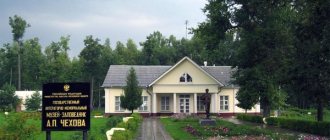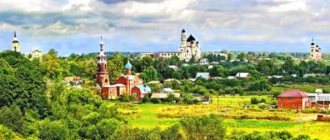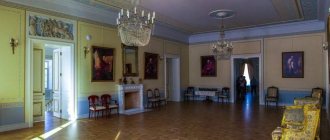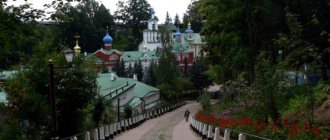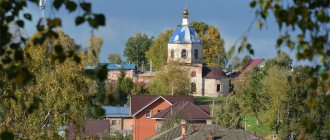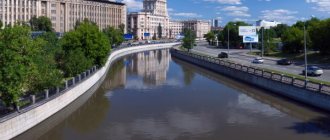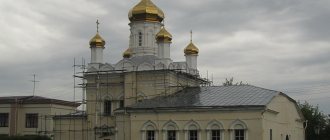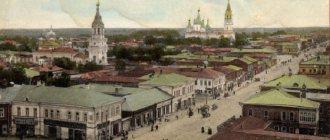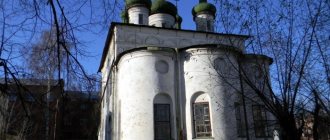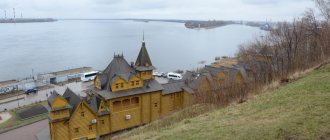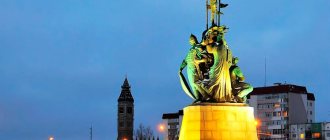What to visit in the vicinity of Naro-Fominsk
Tubing park Elagino
This entertainment complex is located in the village of Elagino, 10 km south of Naro-Fominsk. Wonderful conditions have been created here for a ski holiday in the Moscow region. The trails are equipped with the latest technology, and the staff is always ready to help if necessary.
The territory of the tubing park is very huge, you can stay there all day, because in addition to active recreation, you will also be offered passive recreation - sit in a warm cafe, warm up with a cup of coffee and eat delicious kebab. Children from 5 years old will simply be delighted with this attraction.
Zosimova Pustyn Convent
27 km east of Naro-Fominsk is the village of Zosimova Pustyn, where the Trinity-Odigitrievsky stauropegic convent of the same name is located. This Orthodox monastery was founded back in 1826 by the monk Zosima.
Like many other shrines in Russia, during the Soviet period it was not used for its intended purpose - both a pioneer camp and an agricultural artel were located here.
It was returned to the Orthodox Church in 1999, and in 2000 it received the official status of a monastery. The main monastery churches are the Trinity Cathedral and the Church of John the Baptist. And not far away you can find the mass grave of pilots.
Wake Park Wannawake Park
In the small village of Shapkino, 27 km west of Naro-Fominsk, there is another interesting place for active leisure - the first area Wake Park, located next to small reservoirs. From the reviews it becomes clear that this place is far from ideal, there is still a lot of work to be done here, but overall the feedback is positive. Many people note that the winch in Wannawake Park is very decent, they say, there is a good place where you can go for the weekend. And the conditions here are decent for fishing.
Nowadays, many tourists, when choosing a route to travel around the Moscow region, are increasingly choosing to travel for one day. Hapo-Fominsk is a relatively young city, since it is not even a hundred years old, so its history is most associated with the events that occurred during the Great Patriotic War. A visit to it will be especially useful for those who are interested in this topic. However, even simple travel lovers will not be disappointed after examining the sights of Naro-Fominsk - all or at least part of them.
House with toys
Many visitors to the city will be interested in unusual sights. Naro-Fominsk has an amazing house on its territory. Locals call it the “Wizard’s House.” The small building itself and the buildings adjacent to it are hung with toys, color pictures, and mirrors. The history of this house is amazing. Nikolai Panferov (owner of the “magic” house) recalls that it all started with one toy, once brought to a summer cottage and hung on the fence. The collection began to grow spontaneously, and this process continues to this day. Sometimes tourists come to the house and give toys. Children from orphanages are frequent guests here.
Natural attractions, parks and buildings
Nara River
The picturesque Poochya reservoir, the left tributary of the Oka. The first detailed description dates back to 1627, in the “Book of the Big Drawing” compiled in the Rank Order. The length of the river is about 160 km.
It originates in Lake Poletsk and, flowing through the Nara ponds, flows into the Caspian Sea.
The banks of the Nara are the location of the ancient cities of Naro-Fominsk and Serpukhov near Moscow, as well as historical villages mentioned in the history of the Patriotic War of 1812.
Estate "Petrovskoe"
Address: Naro-Fominsk urban district, Petrovskoye village, Zavodskaya street. How to get there: from the capital along the Kievskoe highway, after Aprelevka turn right, go to the village. Petrovskoe.
The ancient estate, listed in guidebooks as the “Petrovskoye-Knyazhishchevo Estate”, is a landscape and architectural ensemble in which the main elements are ruins:
- manor house (destroyed);
- 4 outbuildings (one is a residential building, one of them is a post office);
- Church of Peter the Metropolitan (destroyed);
- bell tower from 1780 (active)
- Church of the Intercession of the Blessed Virgin Mary (later extension);
- fragments of the park composition.
The most famous owners of the estate were the industrialists Demidovs, then the princes Meshchersky.
According to legend, these lands were called Knyazhishchevo and were donated by Peter the Great to his advisor Shafirov Peter, who built the wooden church of Metropolitan Peter. Hence the name of the estate.
The estate flourished during the “Demidov” period. Historians claim that Petrovskoye-Knyazishchevo of those times could compete in beauty and decoration with the estates of Arkhangelskoye and Kuskovo, but it suffered the fate of ruin.
Afineevo Estate
Address: Naro-Fominsk district, Aprelevka village How to get there: from the Kievsky railway station of the capital to the station. Aprelevka, walk 4.5 km
Afineevo is a cultural monument in the Moscow Baroque style. Today, tourists can take a photo against the background of the preserved foundation of a noble house, an ancient fountain and walk along the marble path of the estate. The only surviving element of the composition is the Church of John the Baptist.
The estate is named after the village of Afineevo, and this name has an interesting history. It was told by theater expert Yu. A. Bakhrushin, who lived here in 1913. The village was once called Fineevo, because in ancient times there was a Finnish settlement in its place. Evidence is preserved Finnish burial mounds, one of which Bakhrushin allegedly personally excavated.
Spas-Kositsy Estate
Address: Naro-Fominsk district, Spas-KositsyHow to get there: bus No. 41 from Vereya Bus Station
Spas-Kositsy is the estate of the titled noble family of the Shuvalovs, the construction of which dates back to approximately the mid-18th century.
From the once rich estate, the remarkable temple complex of the Church of the Transfiguration of the Lord and the bell tower not adjacent to it have survived. They contain features of both Catherine and Elizabethan baroque, as well as elements of the “pilaster” style, which makes the estate a rare architectural example.
Historical and architectural sights of Naro-Fominsk: Lyubanovo estate
This estate is located in the village of the same name in the vicinity of Naro-Fominsk, on the banks of the Nara River. Today it bears little resemblance to a luxurious estate, built in the neoclassical style with some modern elements. After construction, this house became one of the richest in the Moscow region.
The estate dates back to the end of the 17th century. It was built by K. Czartoryski. It belonged to his family until the mid-19th century. The first owner was distinguished by a cruel disposition: the walled remains of mutilated serfs were found in the walls of the estate's basement.
In 1881, Privy Councilor K. Schlippe became the owner of the estate. But in 1917 he was repressed. In September 1920, F.E. Dzerzhinsky visited the estate. Nowadays a rural school is located here.
Temples and chapels of Naro-Fominsk
St. Nicholas Church
Address: General Efremov, 2.
Until 1812, instead of the current parish, there was a wooden St. Nicholas Church and, according to legend, Napoleon Bonaparte himself stayed overnight there during the Patriotic War. During the retreat, the French burned the temple.
In 1845, construction began on a new, more durable sacred structure, designed by the architect Burenin. Funds for construction were allocated by local landowners – Skuratov and Lukin. The first parishioners were received in the renovated church in 1852; at that time it was one of the most beautiful in Russia.
St. Nicholas Church has a rich history: after the revolution, it was first turned into a guardianship for the poor, then into an almshouse, then closed completely, and during the war years it was mercilessly looted. In the post-war period, it first became a warehouse, and later - the historical museum of Naro-Fominsk. In 1989, they decided to return it to believers. Thus began a restoration that lasted until 2004.
Now the Church of St. Nicholas lives a full-fledged Orthodox life: services and sacred rites are held there, and Sunday schools are open for parishioners of all ages. It possesses such shrines as particles of the relics of the great martyrs, ancient icons, and arks.
Chapel of Our Lady of the Unquenchable Lamp
Address - pl. Victory, 1.
The “Unquenchable Lamp” chapel appeared in Naro-Fominsk in 1990 - as a repository of the Eternal Flame in memory of the fierce battles that took place at this place in 1942 for the defense of Moscow
It fits organically into the composition of St. Nicholas Church and, along with it, is an important landmark of Naro-Fominsk
Temple of New Martyrs and Confessors
Address: Shibankova microdistrict.
In the north of Naro-Fominsk there is also an Orthodox parish - small, but very interesting. It cannot boast of much history, since it was erected in 2021. It has only one dome - gilded, with a cross. The facade of the building is whitewashed, the roof is dark. The cathedral is surrounded by a beautiful park of trees, apparently planted a long time ago.
St. Nicholas Church
Orthodox sights of Naro-Fominsk mainly date back to the beginning of the 19th century. And the wooden St. Nicholas Church existed even before 1812. In 1845, the first stone was laid for the construction of a stone cathedral. The author of the project was the architect P. Burenin. In 1852, construction work was completed.
In 1904, a sacristy, an almshouse, and a chapel of St. George were built on the territory of the temple. At the same time, a trustee society for the poor was founded here, and the foundation of a refectory was laid. In 1930, the temple was closed to believers.
The St. Nicholas Church community was registered in 1989. A dome and a cross were installed, and in 1999 an iconostasis appeared in the cathedral. Complete restoration and interior decoration of the walls with frescoes was completed in 2004. Today, the church (since 1998) operates Sunday schools for children and adults. The honorary rector of the cathedral is Bishop Ilian Vostryakov, the rector is Archpriest Oleg Mitrov.
Monuments and memorials
Monument "Tank T-34"
Address - pl. Victory, 1.
Hapo-Fominsk is a city of military glory. The battles near Nara belong to the category of those whose memory will live for centuries.
In the fall of 1941, it was here that the Red Army stopped the advance of the German army. The feat of G.G. has gone down in history. Khetagurov, who destroyed the enemy headquarters on a KV-1 tank, causing irreparable damage to the enemy. There is a version that the T-34 Tank stands exactly on the spot where this event took place.
The T-34 Tank serves as a reminder of the power of our weapons and the valor of the Soviet people during the war.
Monument to M.G. Efremov
Address - pl. Victory, 1.
Lieutenant General Mikhail Grigorievich Efremov - commander during the Civil War. During the Second World War, he was the commander of the 33rd Army, which defended the approaches to the capital Moscow near Naro-Fominsk.
In the spring of 1942, the Germans surrounded the army. In order not to be captured, three times wounded Efremov decided to shoot himself. At the same time, his entire staff committed suicide. The invaders did not take anyone from the 33rd Army prisoner voluntarily - this is what German archive sources say.
Protiney, having captured the line, paid tribute to the worthy enemy by burying the lieutenant general with honor near the village of Slobodka. Efremov was awarded the title of Hero of the Russian Federation in 1990.
Stella "City of Military Glory"
Address: Victory Square.
Hapo-Fominsk became the “City of Military Glory” in 1990, and a year later a commemorative stele with the coat of arms of Russia 12 m high was erected on the main city square. At the foot of the monument there are three tables: one with a literal presidential decree conferring the honorary title on the city, another with a description of the feat of Naro-Fominsk during the Second World War, the third contains tragic figures for the number of victims and destruction that the region suffered during the war.
Monument "Black Tulip"
The address is a square on Lenin Street.
“Black Tulip” is a memorable tribute to the valiant internationalist soldiers who gave their lives in the line of duty in Afghanistan. The opening of this memorial took place in 1991.
All honors for soldiers who fought in Afghanistan take place near this sad memorial. The memory of those who did not return from the Afghan war is also honored here. In the Narofominsk region, almost 400 people served in Afghanistan, 23 of them were unable to return alive.
The monument is located in Memory Square. Next to it there are memorial plaques with a list of dead residents of Naro-Fominsk who took part in other local clashes and conflicts.
Sculptures and monuments
Dozens of monuments and sculptures have been erected in Naro-Fominsk:
- Monument to General Efremov. The monument is dedicated to the Soviet leader and leader. Brave and courageous Efremov fought against German troops, but at some point the Russian army was defeated. In order not to show obedience, Efremov wanted to commit suicide. Other chiefs of staff followed his example. In the early 90s of the 20th century, M. G. Efremov was awarded the title of Hero of Russia. The attraction is located on Victory Square in Naro-Fominsk.
- Monument to Latvian riflemen . The monument was erected in the 20th century after the end of the Second World War. Latvian soldiers fought against the German invaders, supporting the Soviet army. In 1941, Latvian soldiers fought for the liberation of Naro-Fominsk. In honor of the brave soldiers, a monument was built, which was updated in 2005. Today there is a park near the monument; on holidays people come here with flowers to honor the memory of the victims. The object is located in the village of Metropolitan.
- Sculpture “Emelya on the stove”. The monument was made by sculptor Novoselov. An unusual object is located on Marshal Zhukov Street. The sculpture appeared in 2008, depicting the hero from the Russian fairy tale Emelya, who lies on the stove, and next to him stands a suitcase with a pike looking out. According to some beliefs, when you are near the monument, you need to make a wish and throw a coin into the pike’s mouth.
- Sculptural composition “Hearts of Lovers”. The monument appeared in 2008 in Naro-Fominsk on Marshal Zhukov Street. This monument is dedicated to lovers and is considered the first thematic monument in the vicinity of Moscow. The sculpture is made in the shape of two hearts, inside of which there is a couple in love. According to local tradition, newlyweds must visit this place on their wedding day so that happiness and harmony always reign in the marriage.
- Monument "Black Tulip". The monument is dedicated to the soldiers who fought in Afghanistan. The monument is made in the shape of a tulip; it appeared on the city street in 1991. During holidays and rallies, caring residents bring flowers to the monument. The Black Tulip monument is located in the Memory Square on Rizhskaya Street.
Monuments and museums
Stele of Military Glory
Address: Victory Square
The twelve-meter marble monument is the youngest city monument of historical scale
Its construction was preceded by an important event: the presentation of a government certificate confirming the title “City of Military Glory”. The status was assigned on May 8, 2009, and the stele was inaugurated exactly a year later.
The upper part of the monument is crowned with the Russian coat of arms, and its edges contain commemorative inscriptions. They are dedicated to the heroic days of the battle for Moscow, in which Naro-Fominsk played the role of the last frontier - impregnable for the enemy.
Monument to the T-34 tank
Address: Victory Square
The memorial building personifies the power of Russian weapons and the valor of the soldiers who fought here in 1941. The plaques on the pedestal (there are 2 of them) are dedicated to the motorized rifle division and tank brigade that were able to stop the fascist offensive.
According to one version, in the place where the T-34 tank was installed, the legendary “fire raid” of Lieutenant Khetagurov began, who smashed the enemy’s headquarters in his military vehicle.
Central Museum of Armored Weapons
The museum was founded in 1938. It occupies an area of 12 hectares, where exhibits are located - 350 units of armored vehicles and weapons from 14 countries. The museum's collection is unique with individual samples in the amount of 60 units: they exist in the world in a single copy.
An example of such an exhibit is the English Vickers-Carden-Loyd amphibious tank, which has existed since 1931. This is the prototype of all floating tank models in the world. On land in combat, this vehicle proved to be unreliable, but was actively used for reconnaissance purposes.
Since 2014, the museum has been renamed and is now known as Patriot Park. It is the largest tank museum in the world and has no analogues.
Museum of History and Local Lore
The museum is a budgetary cultural institution. Its chronicle dates back to May 9, 1973. Until 1991, it was located on the premises of the St. Nicholas Church, but then it was moved to one of the historical houses on the central street of Naro-Fominsk.
The museum has a rich fund of exhibits of 25 thousand items. Exhibitions and programs are dedicated to the ethnography of the region, glorious and difficult pages of the city’s history, and memorable dates.
Monument "Black Tulip"
Address: square on Lenin street
A forged open black bud on a pedestal is a memorial to Internationalist Soldiers. It was opened in 1991.
All celebrations of Afghans, of whom there are about four hundred in the Narofominsk region, take place here. This is a place of memory for those townspeople who died giving their international duty (23 Soviet soldiers from Naro-Fominsk).
Sculpture of Emelya on the stove
Address: Marshal Zhukov Street, near the administration
Emelya on the stove in Narofominsk style is a funny character with an umbrella, a suitcase, and a fabulous pike to boot. This is how the author of the monument, Gennady Novoselov, saw the hero of the folk tale, and since 2008, all the townspeople and guests of Naro-Fominsk.
When making a wish, don’t forget to add “according to my wishes.”
The sculptor dedicated the sculpture to travelers, because his Emelya stove is on four wheels - a car, a motorcycle, a helicopter and a cart. You can also see a boat propeller from the back. The uniqueness of the sculpture is that it does not contain a single separately cast element.
Panel "Lenin and people"
Address: st. Freedom Square
The famous panel decorates the building of the former Naro-Fominsk silk factory. The huge building, occupying almost an entire block, is in itself a symbol of Soviet culture, a fragment of the recent historical past.
The panel, the plot of which is made in the spirit of a Soviet poster, is mosaic. It was created by artist Yuri Dekhto for the 125th anniversary of the plant in 1965.
Museums
In Naro-Fominsk and its surroundings there are dozens of museums telling about the events of the past:
- Museum of History and Local Lore. The facility was founded in 1973 on the territory of St. Nicholas Church. Since the early 90s of the last century, the museum was moved to Marshal Zhukov Street. Today the museum offers more than 20 thousand exhibits. In the local history museum you can learn about the history of Naro-Fominsk, about past figures of the city and the life of ordinary working peasants. At the military exhibition you can get acquainted with the events of the Second World War: See valuable material evidence. Photos. Front-line things of soldiers. Front letters. You can visit the museum on any day except Sunday and Monday. Cost: from 150 rub.
- Vereisky Museum of History and Local Lore. The facility is located in the city of Vereya, in the Naro-Fominsk region. The museum was founded at the end of the 20th century on the initiative of local historians. The building in which the museum is located formerly belonged to a local merchant. It is located on the banks of the Protva, not far from the Nativity Cathedral. The museum displays military exhibits, photographs, and personal belongings of soldiers. There is a historical and ethnographic hall on the territory. At the exhibitions you can learn about the past of the Naro-Fominsk region, its development and situation during the Second World War. The cost of excursions is from 100 to 1000 rubles, visits take place on weekdays.
- Tank Museum in Kubinka. The museum was created in 1938. The museum is presented in the form of a park with an exhibition of military equipment used in various historical times. The park displays about 350 types of armored vehicles from around the world. The exhibition is located in Kubinka and can be reached along the Minsk Highway. You can visit the museum any day except Monday. The exhibition is open from 10 am to 6 pm.
Today, on the territory of the museum there is a cafe, bicycle rental and various souvenir shops. The ticket price varies between 400 rubles.
Decoration sculptures in Naro-Fominsk
"Hearts of Lovers"
Address – Zhukova, 12.
The composition “Hearts of Lovers” was created by sculptor V.F. Mitroshina. It decorates the square near the Wedding Palace and is made in the form of an arch of two hearts, under which two lovers walk towards family happiness.
Today it is a traditional place for newlyweds, who at the end of the wedding ceremony symbolically pass under this arch. “Hearts of Lovers” is the most romantic monument in Naro-Fominsk and one of its highlights.
"Emelya on the stove"
Address: Marshala Zhukova, 6.
This sculpture appeared in Naro-Fominsk in 2008 and immediately won the love of townspeople and visitors. It is believed that it is dedicated to travelers. The fairy-tale character Emelya, with an umbrella in his hand and a suitcase at the ready, sits on a stove resting on wheels from four types of transport - from a cart, from a car, from a motorcycle and from an airplane, which symbolize the evolution of means of transportation.
Pike also plays an important role in this funny composition. There is an opinion that your cherished wish will come true if you entrust it to this fish. The main thing is not to forget to say the famous saying from a Russian folk tale.
The author of the sculpture is the monumental artist, blacksmith G.V. Novoselov. “Emelya on the stove” is not his only creation in Naro-Fominsk. He is also the author of the “Black Tulip”, a monument to fallen soldiers while serving in Afghanistan, and the forged doors in St. Nicholas Church. But “Emelya on the Stove” is unique in that there is not a single separately cast element in this sculpture.
Spas-Kositsy Estate
This small town near Moscow has very interesting architectural sights. Naro-Fominsk is known far beyond its borders for the estate built in 1761 by Count A. Shuvalov. The Spas-Kositsy estate was famous for the churches built on its territory.
The first church to be erected was in the name of the Transfiguration of the Lord. Today only the church itself has survived, while the manor house and outbuildings have been completely destroyed. The domed pentagonal church is made in the Elizabethan Baroque style. In the bell tower, in addition to the belfry, the Church of Simeon the Stylite was created. On the territory of the Transfiguration Church there is a tomb of the Shuvalov family.
During the Soviet years, the church was destroyed and services were suspended. In 1942, the village of Spas-Kositsy was occupied by German troops. Everything was already ready for the terrible execution - the Nazis planned to burn all the village residents alive. Fortunately, the 6th Automatic Division of the People's Militia managed to save civilians. This is stated on the memorial plaque located on the western wall of the temple.
Church of St. Nicholas the Wonderworker
There are also more ancient sights of Naro-Fominsk. For example, the Church of St. Nicholas the Wonderworker was built at the beginning of the 14th century. The structure is a white stone, pillarless, single-domed church with three apses. For Russian church architecture, the building plan is quite rare.
It represents the shape of an equilateral cross inscribed in a square. The branches are covered with inclined arches; pylons are installed to serve as support for them. The temple is famous for its light drum, which has eight high slitted windows.
In 1938 the temple was closed. In 1975, restoration was carried out according to the design of the architect B. Altshuller. Since 1990, the temple came under the control of the Russian Orthodox Church, and since 1999, services have been held there.
Estates
In the vicinity of the city there are preserved estates belonging to active figures from different times:
Lyubanovo estate. The object was built in the 20th century by the architect Behrens. The owner of the building was Karl von Schliepe. It is located on the banks of the Nara River. The building was made in Art Nouveau style, and to this day its residential part remains decorated. The kitchen, bedrooms and bathhouse with laundry room have been preserved here. On the territory of the spectacular building there is a park and a ruined grotto. At the beginning of the 20th century, there was a hospital for revolutionary figures in the estate. Dzerzhinsky was treated for tuberculosis here for a long time. After a while, the hospital was closed, and in its place a school for local children was formed. Today the estate is at the disposal of the municipal library. You can visit the building on weekdays; it is located in the village of Lyubanovo. Staro-Nikolskoye estate. The building was erected in the 17th century. The owner of the property was Rtishchev, but after 1780 the owners changed regularly. Every year something new was added to the building's design. Today, the ancient gates, an outbuilding, and the architectural features of a two-story house have been preserved on the territory of the estate. In Soviet times, there was a store here; in 2011, there was a serious fire in the house and the building was badly damaged. Restoration work was carried out for about a year; the authorities wanted to preserve the original appearance of the estate. Today there are various exhibitions and expositions here, offering insight into the events of past years. In the future, it is planned to organize an exhibition telling about the history of the Staro-Nikolskaya estate. The ancient property is located in the Naro-Fominsk region, in the village of Pervomaiskoye. Visits are available on weekdays. Spas-Kositsy estate. The facility was founded in 1761 for Count Shuvalov. Following its installation, a small church was built here. Today it is the only building remaining on the property. The historical place is considered an architectural monument. The remaining temple was practically not restored; today it is in a dilapidated state. Despite this, church rites and services are performed here to this day. During World War II, German soldiers kept Russian hostages in the church and wanted to burn them. Domestic soldiers took timely measures, and the villagers were soon freed from captivity
A memorial was erected in honor of the brave and courageous deed of the soldiers
You can get to the estate on weekdays; it is located in the village of Spas-Kositsy.
Religious sites
Naro-Fominsk, whose attractions are famous for a large number of temples and churches, offers visitors a tourist route through religious sites.
They are:
- Church of St. Nicholas the Wonderworker. The facility was founded in the 19th century during the 40th anniversary of the victory in the Patriotic War. At the beginning of the 20th century, poor people were received in the church building, and during the Second World War the facility was robbed. The military events affected the condition of the church; its walls were marked by shelling, and everything inside was destroyed. After the war, the building was restored and turned into a historical museum telling about the events of past years. Only in 1989 a religious site appeared here again; a cross and domes were installed on the building. Today there is an evening school here, which can be attended by both adults and children. On the territory of the church there is a library and a carpentry workshop. The Church of St. Nicholas the Wonderworker is located on Victory Square, and you can visit it on any convenient day.
- Church of St. Michael the Archangel. The church was erected in 1790. Prince Shirinsky-Shakhmatov was buried in the church. During Soviet times, there was a store here; after the collapse of the USSR, the building gradually collapsed. Thanks to the attention of local residents, the church was restored. Today rituals and services are held here. The facility is located in the village of Arkhangelsk.
- Sergievskaya Church. The facility was built by order of Lopukhin, a local boyar. The church is located on the shore of a pond, which Lopukhin also ordered to dig. During the Soviet period, the work of the church was suspended; they wanted to build a farm in its place. Since the early 2000s, restoration work has been carried out here, and today rituals and services are held in the church. The facility is located in the village of Mogutovo. You can visit the temple on weekdays from 9 to 5 o’clock.
City of Military Glory
The main attractions are related to the war. In the mid-autumn of 1941, when German troops were attacking Moscow, Naro-Fominsk took the greatest blow. Fierce battles took place here, the enemy was stopped on the Nara River. In 2009, for past heroic events, it was awarded the status of “City of Military Glory.”
There is something to see on the military topic here:
- At the place where the liberation began, a monument to the T-34 tank was erected.
- A year after Naro-Fominsk was awarded the status of “City of Military Glory,” a 12-meter marble stele was unveiled on the central Victory Square in memory of this event. Below on the signs you can read the following information: the decree of the President of the Russian Federation on assigning the city status, a story about the feat of the townspeople during the war years, information about the dead residents and destroyed buildings. The stele, although modest, looks majestic.
- On December 26, 1941, the city was finally liberated by Soviet troops, commanded by General Efremov M.G., one of the central streets was named after him and a pedestal was installed.
Dimitrievskaya Church
Many city attractions are still of great interest to historians. Naro-Fominsk attracts researchers with its ancient religious buildings. A special place among them is occupied by the Demetrius Church in Dubrovo.
It was built in the 14th century by Dmitry Donskoy, in honor of the Great Martyr Demetrius of Thessalonica. The stone temple, which now stands on the banks of the Protva, was built by the priest-brothers Pshenichnikov (1896) in the pseudo-Russian style, according to the design of the architect A. Nikiforov. This is a single-domed quadrangle with a refectory, connected to the base of a tent-roofed (two-tier) bell tower.
In 1930 the temple was closed. Since 1994, a large-scale restoration has been carried out here, and in 2003 the cathedral was completely restored.
What to see in one day in Naro-Fominsk
Figure “Heart” at the central registry office of Naro-Fominsk
You can get acquainted with the main attractions of the city in one day. Initially, it is worth visiting Victory Square and seeing the stele of the “Hero of Military Glory”, the monument “T-34 Tank” and other exhibits. From there it is convenient to get to the Naro-Fominsk Museum of Local Lore on Zhukova Street, where city guests will be introduced to the heritage of the locality. It is best to complete the route in Victory Park, where a commemorative model of the MiG-21 aircraft is located. It’s also nice to stroll through beautiful places along the Nara River.
If you have two days at your disposal, it is worth going on an excursion to the village of Zosimova Pustyn, preferably accompanied by a professional guide. Here you can look at such popular shrines as the Trinity-Odigitrievskaya Zosimova Hermitage, the Church of John the Baptist at the ancient estate of Afineevo. And then look into the famous and mysterious house with toys, located near the Desert.
The church is the only surviving building in the Afineevo estate
What to visit for a tourist in 2-3 days
With a couple of days at your disposal, the number of places to visit increases.
Approximate route for the first days:
- Museum of History and Local Lore.
- Church of St. Nicholas the Wonderworker, St. Sergius Church.
- Elagino Park, Mound of Glory.
- War monuments, sculptures.
- House with toys, springs on the Protva River.
The last day can be devoted to entertainment and go to Vialand to sing karaoke and play bowling.
Parks
The city has parks, squares and alleys:
- Vorovsky Park. The park was founded in the 20th century after the Second World War. Today, various city events take place here; the park has a dance floor, benches, and beautiful alleys. During the celebration of Maslenitsa, festive rituals and folk festivals are held here. In Vorovsky Park there is a sports complex where anyone can go ice skating. You can find a place on Vorovskogo Park street.
- Victory Park. The park is dedicated to the soldiers who died during the war. There are military monuments and objects here, including a monument to fallen Soviet pilots, made in the form of an airplane. The park has a cozy atmosphere; locals come here to relax, relax and look at the beautiful fountain. You can find the place on Profsoyuznaya Street.
The best establishments according to Bebeshka.info visitors
2
Iceberg-Jel
- Moskovskaya street, 15
- +7 (49634)…Show phone
- Mon-Fri 9:00–16:00
Categories
: Ice cream parlor
1
Travel agency Leisure and Tourism
- Marshal Zhukov street, 24A
- +7 (49634)…Show phone
- Mon-Fri 10:00–18:00
Categories
: Travel agencies, Children's excursions
- Yuzhny microdistrict, Lenina street, 25A
- +7 (985) 1…Show phone
- daily, 8:00–22:00
Categories
: Aerobics for children - sections and schools, Children's health centers, Sports and entertainment centers for children, Fitness clubs for children
33 Penguins
- Svoboda Square, 2, bldg. 1
- 8 (800) 10…Show phone
- daily, 10:00–22:00
Categories
: Cafe, Ice cream parlor
Vialand
- Kalinina street, 4
- +7 (49634)…Show phone
- Mon-Fri 12:00–0:00; Sat 12:00–5:00; Sun 12:00–0:00
Categories
: Entertainment centers
ZkidZ Club
- Marshal Zhukov street, 13
- 7 (925) 05…Show phone
- daily, 10:00–22:00
Categories
: Sports and entertainment centers for children
Aquarium
- Tunnelny proezd, 7A
- +7 (49634)…Show phone
- Mon-Thu 12:00–23:00; Fri, Sat 12:00–1:00; Sun 12:00–22:00
Categories
: Cafe
Art-Boom
- Marshal Zhukov street, 10
- +7 (49634)…Show phone
- daily, 10:00–22:00
Categories
: Theaters
Showroom
- st. Marshala Zhukova, 10
- +7 (49634)…Show phone
- Mon-Fri 10:00–18:00; Sat 10:00–17:00
Categories
: Children's exhibitions
Domino
- Kubinskoe highway, c5
- +7 (968) 8…Show phone
- daily, 10:00–23:00
Categories
: Cafe
Ship
- Shibankova street, 89A
- +7 (49634)…Show phone
- Mon-Wed 16:00–2:00; Thu 16:00–4:00; Fri, Sat 16:00–6:00; Sun 16:00–4:00
Categories
: Cafes, Entertainment centers
Ice Palace Naro-Fominsk
- Profsoyuznaya street, 36B
- +7 (925) 0…Show phone
- daily, 6:00–0:00
Categories
: Skating rinks
Nara
- Yuzhny microdistrict, Lenina street, 14
- +7 (49634)…Show phone
- Mon-Thu 12:00–0:00; Fri, Sat 13:00–1:00; Sun 12:00–0:00
Categories
: Cafe
Naro-Fominsk Museum of History and Local Lore
- Marshal Zhukov street, 8
- +7 (49634)…Show phone
- Tue-Fri 10:00–17:30; Sat 11:00–18:30
Categories
: Museums
Origami
- Yuzhny microdistrict, Lenina street, 8
- +7 (963) 6…Show phone
- daily, 10:00–22:00
Categories
: Cafe
Serpentine
- Yuzhny microdistrict, Lenina street, 8
- +7 (929) 6…Show phone
- daily, 9:00–22:00
Categories
: Entertainment centers
BrakeLock
- Kyiv highway, 1, bldg. A
- +7 (496) 3…Show phone
- daily, 9:00–22:00
Categories
: Cafe
Tucano
- Peshekhonova street, 11A
- +7 (965) 3…Show phone
- Mon-Thu 9:00–0:00; Fri, Sat 9:00–1:00; Sun 9:00–0:00
Categories
: Cafe, Pizzeria
Central Park
- Vorovskogo Park street
- +7 (49634)…Show phone
- daily, around the clock
Categories
: Parks of culture and recreation
Elite Ice
- Svoboda Square, 13A
- +7 (999) 9…Show phone
- daily, 9:00–21:00
Categories
: Ice cream parlor
1
Paprika
- Yuzhny microdistrict, Lenina street, 8
- +7 (964) 5…Show phone
- Mon-Thu 10:00–0:00; Fri 10:00–2:00; Sat 12:00–2:00; Sun 12:00–0:00
“I went with a friend to eat and chat. We sat down on the veranda. I was surprised that the waitress brought a bottle of wine already open and poured champagne…” – only 1 review Categories
: Cafe
Zosimova Pustyn
In 1826, Elder Zosim founded a monastery, which was built with donations from the Lepeshkin merchants from Moscow. Zosim is a representative of the old noble family of the Verkhovskys (Smolensk province). After his death (1833), the Church of the Life-Giving Trinity was erected over the elder’s grave.
The construction of the monastery was finally completed in 1856. In 1928 the monastery was closed. Many of its buildings were destroyed. Initially, on the territory of the monastery there were: the Temple in honor of John the Baptist, located at the refectory, the gate church of the icon of the Mother of God, and the Trinity Cathedral.
In 1999, the monastery was reopened, however, the gate temple was not preserved. In March 2000, the monastery was returned to the Russian Orthodox Church.
Natural attractions
Naro-Fominsk, whose sights are rich in natural objects, is open for visits at any time of the year:
- Springs on Protva. This is a unique object that includes a system of streams and waterfalls (up to 5 m high). All local streams and springs flow into the Protva River. The waterfalls are surrounded by picturesque views that do not lose their beauty in any weather. Access to the reservoir is only possible on foot, so you will need to leave your car at the garden farm. There are springs near the settlements of Zolotkovo and Merchalovo.
- Elagino Park. The park was built for lovers of active recreation. Here you can ski, snowboard, ski lifts and simply enjoy the picturesque views. There is a restaurant on site, from the windows of which you can see a steep slope. Ski rental is available. Extreme walks are accompanied by music and lighting design, which creates a favorable atmosphere for relaxation. You can visit the park with children; there are various attractions for them. The facility is located in the village of Elagino, 10 km from the city.
- Mound of Glory. The mound is presented in the form of an observation deck, which reaches 15 m in height. The roof at the top of the mound is equipped for viewing the area; you can get to the top using a ladder. The view from the roof opens onto an abandoned landfill, which was given over to local residents working in agriculture.
The observation deck offers beautiful views of the vegetation, so graduates of local schools often come here to watch the sunrise. The mound is located in the village of Kalininets, within 25 km from the city.
Don't miss the most popular article in the section: Metro Nizhny Novgorod. Diagram, map, description.
Interesting and unusual places
In Naro-Fominsk there are interesting art objects and places for extreme recreation:
- The building of a former silk factory. The object is famous for the composition “Lenin and the People” executed on it. The silk factory was built back in the 19th century. Today the building is an architectural monument of the city. The composition, made in a revolutionary theme, complements the architecture of the ancient building and is considered one of the main historical sites of the city. You can find the former plant in the city center on Marshal Zhukov Street.
- Wannawake Park. The park is presented as a platform for water ski lovers. The facility is located in the village of Shapkino on the shore of a reservoir. Here you can try your hand at water skiing, go to training with experienced specialists and learn new skills. The extreme sport began to gain its popularity not so long ago, but Wannawake Park has already gained particular popularity. The facility is located 15 km from Naro-Fominsk.
- House with toys. The facility is located in the settlement of Zosimova Pustyn, next to the convent. The owner of the house collects soft toys and decorates his home, fence and trees in the yard with them. N. Panferov, the owner of the site, invites all the children to see the collection of toys that many local residents help him collect. The unusual house is located 25 km from the city.
